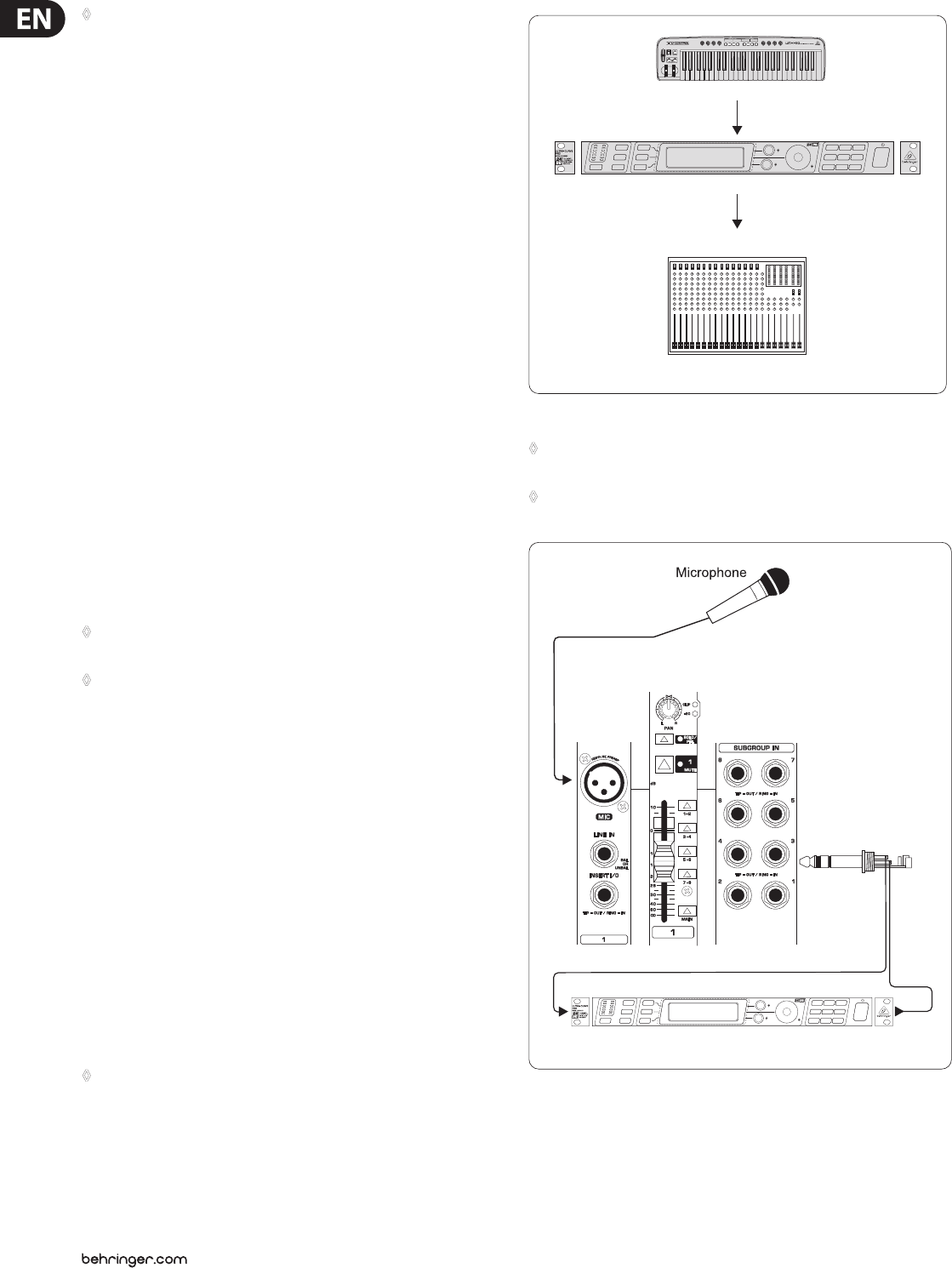
10 EURODESK SX3282 User Manual
◊ A stereo equalizer is generally preferable to using two mono equalizers
when EQ-ing a stereo signal, as often discrepancies between left and
right settings can occur.
4.3 Aux Sends
These are the same as for mono channels (see section 3.3).
4.4 Routing & Muting
The only dierence here from the mono channel described in 3.4 is in the
implementation of the pan control. When a channel is run in mono, there is no
dierence at all.
In stereo operation however, this control functions as a BALANCE control(19),
determining the relative balance of the left and right channel signals being
sent to the left and right main mix buses, or odd and even subgroup buses.
Forexample, with the balance control turned fully clockwise, onlythe
right portion of the channel’s stereo signal will be routed to any or all of
buses R, 2, 4 etc.
5. Subgroups and Inserts
5.1 Subgroups
The principal routes to multitrack are via the subgroup outputs. There are eight
mono (or four stereo) subgroups. All channels can access all of them, as can aux
returns 1 and 2 ((47)). Subgroup level is determined by the Subgroup fader (20),
while the signal level may be accurately checked by solo-ing ((22)).
Subgroup outputs can also be assigned to the main mix during mixdown by
pressing the MAIN MIX switch (21), in which case stereo position in the L R mix is
determined by the subgroup’s PAN pot (23).
◊ Try inserting compression/de-essing/an exciter or a noise gate across
grouped signals (e.g. backing vocals, drums, layered synths).
◊ Try merging a dry signal with a little wet, then compressing the sum
heavily. Though the reverb proportion will be low when a signal is
present, the resultant reverb tail pumped up by the compressor at the
start of each silence will give the illusion that the reverb was massive
at the time. (The listener will be left wondering how the singer could
sound so clear in such a wet acoustic!)
5.2 Insert Points
Insert points are useful for adding dynamic processing or equalization to a
channel, a group, or the mix. Unlike reverbs etc., which are usually added to
the dry signal, dynamic processing is normally applied across an entire signal.
Herean aux send would be inappropriate. Instead the signal is intercepted
somewhere along the channel, fed through the dynamics processor and/or EQ,
then returned to the console at the same point where it left. The insert point is
normalized, i.e. the signal is only interrupted when a jack is plugged into it.
All mono input channels have got insert points, as have the subgroups and the
main mix. Each insert point is accommodated on a single TRS jack socket wired
tip = send, ring = return, sleeve = ground/screen. Inserts are always pre-fader,
and also pre-EQ/pre-aux sends for channels.
◊ If you want to insert a dynamics processor etc. into one of the stereo
channels, it must be done between the source output and the SX3282,
as these channels have no bona-fide insert point.
Keyboard
ULTRACURVE PRO DEQ246
Stereo Channel/Input
SX3282
Fig. 5.1: Inserting into a stereo channel
◊ Please note that we didn’t draw the ground/screen connection in the
following graphics to keep them as simple as possible.
◊ If you want to insert an external EQ or dynamics processor post-EQ,
a subgroup insert should be used as follows:
Channel 1
Input
Subgroup 1
Insert
Send
Return
ULTRACURVE PRO DEQ2496
Fig. 5.2: Inserting an external EQ / dynamics processor post channel EQ


















